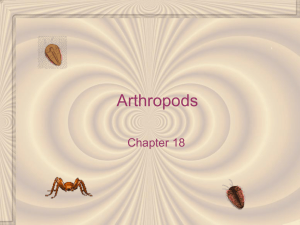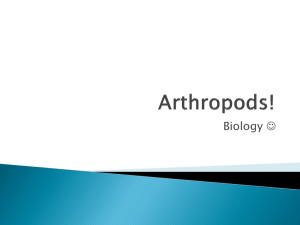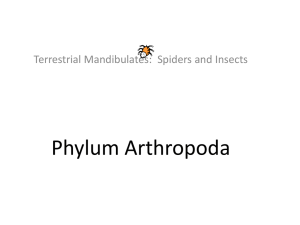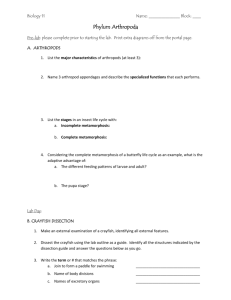Arthropoda Lab Manual: Features, Phylogeny, Classes
advertisement
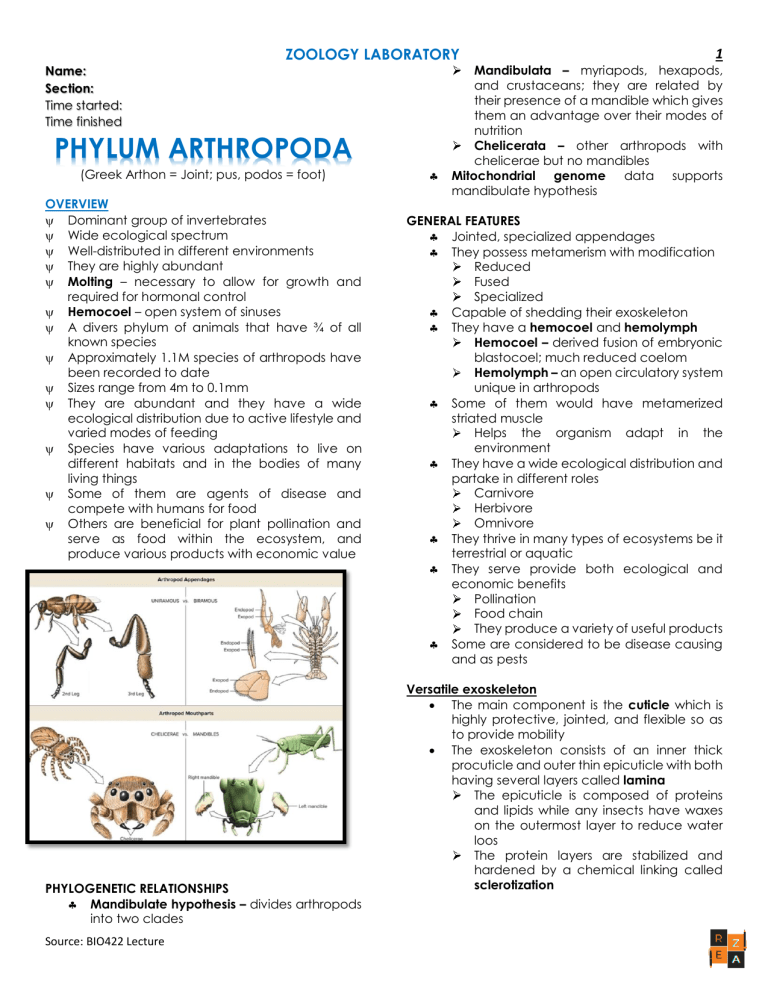
ZOOLOGY LABORATORY Name: Section: Time started: Time finished PHYLUM ARTHROPODA (Greek Arthon = Joint; pus, podos = foot) OVERVIEW Dominant group of invertebrates Wide ecological spectrum Well-distributed in different environments They are highly abundant Molting – necessary to allow for growth and required for hormonal control Hemocoel – open system of sinuses A divers phylum of animals that have ¾ of all known species Approximately 1.1M species of arthropods have been recorded to date Sizes range from 4m to 0.1mm They are abundant and they have a wide ecological distribution due to active lifestyle and varied modes of feeding Species have various adaptations to live on different habitats and in the bodies of many living things Some of them are agents of disease and compete with humans for food Others are beneficial for plant pollination and serve as food within the ecosystem, and produce various products with economic value PHYLOGENETIC RELATIONSHIPS Mandibulate hypothesis – divides arthropods into two clades Source: BIO422 Lecture 1 Mandibulata – myriapods, hexapods, and crustaceans; they are related by their presence of a mandible which gives them an advantage over their modes of nutrition Chelicerata – other arthropods with chelicerae but no mandibles Mitochondrial genome data supports mandibulate hypothesis GENERAL FEATURES Jointed, specialized appendages They possess metamerism with modification Reduced Fused Specialized Capable of shedding their exoskeleton They have a hemocoel and hemolymph Hemocoel – derived fusion of embryonic blastocoel; much reduced coelom Hemolymph – an open circulatory system unique in arthropods Some of them would have metamerized striated muscle Helps the organism adapt in the environment They have a wide ecological distribution and partake in different roles Carnivore Herbivore Omnivore They thrive in many types of ecosystems be it terrestrial or aquatic They serve provide both ecological and economic benefits Pollination Food chain They produce a variety of useful products Some are considered to be disease causing and as pests Versatile exoskeleton • The main component is the cuticle which is highly protective, jointed, and flexible so as to provide mobility • The exoskeleton consists of an inner thick procuticle and outer thin epicuticle with both having several layers called lamina The epicuticle is composed of proteins and lipids while any insects have waxes on the outermost layer to reduce water loos The protein layers are stabilized and hardened by a chemical linking called sclerotization ZOOLOGY LABORATORY 2 Many of them undergo metamorphic changes that have different larval and adult stages Larvae and adults feed on different organisms and occupy different habitats to avoid intraspecific competition CHELICERATA Class Merostomata Tachypleus or limulus Arachnida Nephilia or argiope Heterometrus Segmentation and appendages • Provides locomotion • Many segments may be fused or combined into specialized groups called tagmata • Differentiated and highly specialized for division of labor • Limb segments are hollow levers moved by internal striated muscles • These segmentations and appendages allow for Better sensing Better food handling Walking swimming Respiration and sensory organs • They have an efficient tracheal system Terrestrial arthropods have air tibes for direct oxygen transport into tissues and it allows high metabolic rates but may limit body size Aquatic arthropods have internal or external gills on the other hand • They have highly developed sensory organs Eyes ay be simple light sensitive ocelli and ay as well be a compound eye Other sensory structures are for - touch - Sell - Hearing - Balancing - Chemical reception Behavior and metamorphosis • They tend to have complex behavior patterns Arthropods surpass most other invertebrates in complex and organized activities Some of which are innate and some are learned • They use diverse resources through metamorphosis Source: BIO422 Lecture General features Some are terrestrial and some are aquatic Antennae is absent Chelicerae – first pair of appendages is used for feeding due to lack of a jaw or mandible Two-part body plan Cephalothorax (prosoma) – fusion of the head and thorax Abdomen (opisthosoma) CLASS MEROSTOMATA Subclass Xiphosurida (xiphos+surida = sword tail) • Horseshoe crabs (tachypleus sp.) There are 5 species in the genera They mostly live in shallow water They have an unsegmented carapace Cephalothorax (Prosoma) has: - 1 pair of pedipalps - 4 pairs of walking legs - 1 pair chelicerae Abdomen (Opisthosoma) has: - 6 pairs of broad, thin, appendages fused in the median line Carapace has 2 rudimentary and 2 simple eyes • Prosoma and opisthosoma • • • ZOOLOGY LABORATORY 3 Chelicera, gnathobase and chilaria are used for feeding Pedipalps are used for locomotion Telson Behavior • They swim with their abdominal plates open • The feed at night on worms and small mollusks using chelicerae and walking legs • They come to the shore at high tide to mate • Females burrow into sand to lay eggs • Males follow to add sperm before eggs are covered in sand and warmed by the sin • Young larvae hatch and return to sea at next high tide • Larvae are segmented and resemble trilobites Class Arachnida (arachne = spider; araneus = spiderweb) • Most of them are predaceous • Two tagmata: cephalothorax and abdomen is joined by the pedicel • Abdomen: Reproductive organs Respiratory organs - Book gills - Trachea • Cephalothorax: Pair of chelicerae Pair of pedipalps 4 pairs of walking legs • They have around 80,00 species • Most are free living with them being more common in warm, dry regions • Most are predaceous and have: Claws Fangs Poison glands Stingers • Legs have 7 segments • Epigynum conceals the female genital pore • Lung slit and tracheal plate are the parts responsible for the respiration of the organism • They have no antenna or mandibles • Pedipalps of males are modified for sperm transfer • Spinnerets • They have no antenna or mandibles • Sucking pharynx ingests fluids and soft tissues from bodies of their prey • Some spiders have spinning glands to make silken webs for food capture • The abdomen houses the reproductive and respiratory organs Order Araneae (spiders) Source: BIO422 Lecture • • • • • • • • • • • • They have 8 simple eyes, but many of them have poor vision They have around 40,00 species Spiders are predaceous and mostly ambush and trap insects Their cephalothorax is unsegmented (few are segmented) They suck liquefied tissues after injecting venom and digestive juices They have book lungs and trachea for their respiratory organs Malpighian tubules – used for osmoregulation Potassium solutes and wastes drain into the intestines This is considered as an excretory organ for arachnids or spiders Resorptive cells – captures potassium, water, and uric acid Coxal glands – primarily used for excreting urine Sensilla – mechanoreceptors which covers the leg and can detect air currents, web vibrations, and other stimuli Liquid scleroprotein - secretion that hardens as it is extruded Silk – the web; used in forming egg sacs, nest lining, nursery, and wrapping prey Interaction with spiders • Most people fear spiders • Tarantulas are not dangerous • Black widow spiders – dangerous; their venom is neurotoxic • • ZOOLOGY LABORATORY Brown recluse spider – their hemolytic venom destroys tissue around the bite Some Australian and south American spiders are the most dangerous and aggressive species with some of the most toxic venoms which cause intense pain and neurotoxicity 4 GENERAL NATURE OF A CRUSTACEAN Main distinguishing feature is having two pairs of antennae The head also has a pair of mandibles and two pairs of maxillae One pair of appendages on each of the body segments (Some segments may lack appendages) They are mostly marine freshwater and terrestrial species They have around 16-20 segments Ancestral forms had up to 60 segments Major body tagmata Head Thorax Abdomen Order Acari (Akari = tick; Akares = tiny) • Mites and ticks • They are the most medically and economically important arachnid group • Approximately 40,000 species have been described • They can be found worldwide in both aquatic and terrestrial habitats and extend to deserts, polar areas, and hot springs • Many of them are parasitic during at least one life stage • Most mites are less than 1 mm long • Ticks are approximately 3cm in size due to distension from feeding on blood • They exhibit a complete fusion of cephalothorax and abdomen with no signs of external segmentation • Mouthparts are on the tip of the anterior capitulum • Chelicerae help pierce, tear, or grip food • Pedipalps have a fused base called a hypostome • Rostrum or tectum extends dorsally over the mouth CRUSTACEANS Crustaceans are named for their hard exoskeletons They have over 67,000 described living species These organisms also fill a variety of ecological roles Crustacea make up over 80% of all named animal species They are probably the most abundant animals in the world are members of the copepod genus Calanus such that they are called the insects of the sea Source: BIO422 Lecture Crustacean form and fuction • The secreted cuticle is made of Chitin, protein, and calcareous material • Harder and heavier plates have more calcareous deposits • The joints are soft and thin which allows the organism some degree of flexibility • The abdomen ends with telson that bears the anus • • • ZOOLOGY LABORATORY 5 Molting – physiological process of making a larger cuticle Physiology of molting affects reproduction, behavior, and many metabolic processes Occurs often in young animals as they grow and may slow down in adults Environmental factors - Temperature - Day length - Other stimuli that may trigger CNS to begin ecdysis Ecdysis – shedding of the old cuticle needed to grow in size The underlying epidermis of the organism secretes the cuticle Subphylum Crustacea • They are mostly aquatic and terrestrial organisms • Crustaceans have gills • Crustaceans also have an excess skeleton made out of chitin which is subject for ecdysis • Two pairs of antennae are present • Two pairs of maxillae are on the head • There is a pair of appendages on each body segment of the organism • Representative species Class malacostraca Penaeus monodon -tiger shrimp Litopenaeus vannamei – white shrimp Scylla serrata – mudcrab Cambarus sp. or panulirus sp. – lobster HEXAPODA Terrestrial and aquatic organisms Tagmata Head Trunk Abdomen Six legs Compound eyes are present Two pairs of wings on most of the representative species Two classes Entognatha – small group with the bases of mouthparts enclosed within the head capsule Insecta – enormous class that have ectognathous mouthparts, but bases of mouthparts lie outside the head capsule - Neoptera – can fold their wings into the back of the abdomen - Paleoptera – cannot fold their wings into the back of the abdomen Subphylum Hexapoda Class Insecta • General groups are based on wing presence Pterygotes: winged insects Apterygotes: wingless insects Thysanurans: primitive wingless insects • The number of known species is estimated at 1.1M • There is an estimated number of 30M species worldwide • Their exoskeletons have sclerites which are made out of scleroproteins • These organisms have six uniramous legs • They have three body segments Head Thorax - Prothorax - Mesothorax Source: BIO422 Lecture ZOOLOGY LABORATORY - Metathorax Abdomen • Their appendages are attached to the head and thorax • Abdominal appendages may be greatly reduced or be totally absent • Insects can undergo metamorphosis Ametabolous (Direct) – Not true for insects; but true for some arthropods Hemimetabolous (Incomplete) – middle stages are composed of different forms of nymphs with the latter ones having developed an advantage compared to the previous stages Holometabolous (Complete) – they start with an egg, develops into three instars of larvae, develops into a pupa, and eventually emerges as an adult Insect wings • Flies have thin and membranous wings • Beetles have thick and thorny front wings • Butterflies and moths have wings covered with scales Feeding strategies • Most feed on plant tissues or juices and are herbivorous or phytophagous • Some are predaceous on other insects or other animals while others are scavengers or saprophagous • Mouthparts are adapted depending on the mode of nutrition of species 6 • • • Auditory reception – tympanal organs Chemoreception – sensory pits Visual reception – simple and compound eyes • Other senses – temperatures, humidity gravity, and other physical properties Diapause: Period of dormancy • Diapause – an important adaptation to survive adverse environmental conditions • It can occur at any stage and may remain dormant for some time • It is internally controlled but may be as well triggered by environmental cues such as day length, rain, and temperature • Hibernation – winter dormancy • Estivation – summer dormancy • It usually/always occur at the end of an active growth stage so that the insect is then ready for another molt MYRIAPODA Mainly terrestrial found in decaying wood, crevices, rocks, or arboreal Paired appendages Two antennae Compound eyes are absent Sense organs • Mechanoreception – sensilla and seta Source: BIO422 Lecture Subphylum Myriapoda • “Many footed” • Myriapods have two tagmata with paired appendages along most segments • Subphylum Myriapoda has four classes Chilopoda (centipedes) Diplopoda (millipedes) Pauropoda (pauropods) Symphyla (symphylans) • • ZOOLOGY LABORATORY 7 These organisms make use of a trachea to transport gases Their execution is usually done by Malpighian tubules Class Chilopoda • These organisms have flattened bodies • They usually live at moist areas under logs bark and stones • They usually prey on earthworms, cockroaches and other insects • They have venom claws, and they chew with mandibles • These organisms have 15 pairs of long legs • There are approximately 3000 species worldwide • Most of them are harmless but a few large tropical centipedes are dangerous Centipede body plan • 177 segments • Each segment, except the one behind the head and last two, bears a pair of jointed legs • The last pair of legs is longer and is used for sensory functioning • Head One pair of antennae A pair of mandibles One or two pairs of maxillae • Eyes are on either side of the head and consists of groups of ocelli Centipede reproduction • Sexes are separate with unpaired gonads and paired ducts • Some lay eggs and others are viviparous • The young resemble adults and do not undergo metamorphosis Class Diplopoda Source: BIO422 Lecture • • • • • • • • Millipedes are known to be less active than centipedes They prefer dark moist places under logs or stones What they do usually for defense is to roll into a coil Some species secret toxic or repellant fluids from special repugnatorial glands on the side of the body They mostly eat decayed plant matter, but a few eat living plant issue The presence of much more legs gives them a much more graceful movement They don't have a venom claw or poison fang There are more than 10,000 species worldwide LABAN LANG! ZOOLOGY LABORATORY Source: BIO422 Lecture 8
